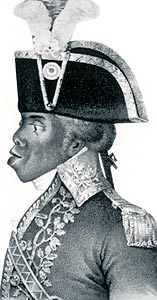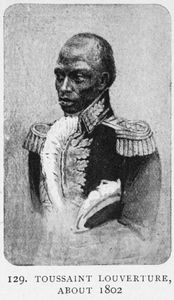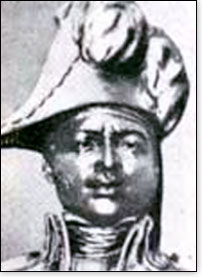|
Toussaint L'Ouverture
Toussaint-Louverture: Summary -- François-Dominique Toussaint Louverture, also known as Toussaint Bréda, and popularly referred to as Toussaint-Louverture was born some time in 1743 and he died on 7th April 1803. In 1791 Tousaint Louverture began to exhibt his natural military flair by leading the slaves of the French colony, Saint Domingue, which was to become Haiti, to rebel against their European captors and 'masters'. The ultimate success of the Haitian Revolution sent shockwaves through the slavery-based businesses and owners of that time and transformed the population of Haiti into a free and self-governing people. A tactically efficient military commander and astute political strategist Toussaint Louverture eventually controlled the whole island after expelling the British. He successfully developed the economy and infrastructuire of the country. But eventually, after proposing an independent constitution for Haiti and becoming governor, in 1802 he was made to resign by Napolean Bonaparte's forces when the French arrived in number to regain the colony. After deportation to France he later died in 1803. The Haitians continued to revolt however, and later in 1804, Toussaint Louverture's protege Jean-Jacques Dessalines declared independence. In 1791, the French Revolution inspired disputes in Saint-Domingue between differing classes of whites and mullatos (persons of mixed white and black parentage).(/p) Almost half a million slaves revolted under their leader, a former slave named François-Dominique Toussaint Louverture. The resulting slaughter of French colonists generated fear in the Spanish, many of them fleeing the island. Nevertheless, it seemed to Spain that this was an opportunity to seize the western sector of the island through an alliance with the British. Toussaint Louverture and his troops, however, resisted all such attempts. Desperate not to lose their colony, the French Republic abolished slavery in 1794. The following year the French, along with Toussaint Louverture's soldiers, easily overwhelmed the eastern Spanish portion of the island, which surrendered to French rule in 1795. Toussaint was appointed Governor General in 1796 in recognition of his leadership against the Spanish, the British, French royalists and the mullatos.  By the following year, as a result of the Treaty of Basle, 1797 (a treaty between Spain and France - part of the on-going efforts in Europe to contain the French revolution) the whole of Hispanolia was surrendered to French control. Toussaint succeeded in re-establishing administrative and economic order on Hispaniola. However, France's new leader, Napoleon Bonaparte, having become concerned about the complaints that former colonists were making about their 'lost' plantations and also uncomfortable that his richest colony was being governed by a black man, decided to take the colony back to direct French rule Napoleon sent his brother-in-law, General Victor Emmanuel Leclerc, to conquer the black administration - and to re-establish slavery. 
Toussaint Louverture was captured in 1801, but the slave forces, now led by his lieutenant Jean-Jacques Dessalines, determinedly held out against their French, Spanish, and British opponents, achieving in 1804 the independence of the western part of Hispanolia, now to be known as Haiti - the first black republic to declare its independence. The eastern two thirds of the island, Santo Domingo, was still controlled by France. Dessalines attempted to take the city of Santo Domingo in 1805, but turned back after hearing of the approach a French naval squadron. COLONIAL DECLINE PIRATES OF THE CARIBBEAN THE TWO COLONIES HOME Return to the top of the Toussaint Louverture page. |













